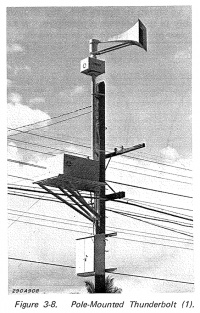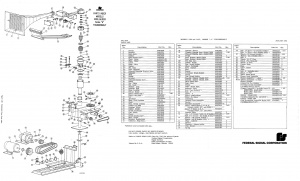Thunderbolt Siren Series: Difference between revisions
No edit summary |
|||
| Line 36: | Line 36: | ||
===Blowers=== | ===Blowers=== | ||
All Thunderbolts run on what is known as a "blower" to push air to the top of the siren to increase sound output. The type of blower has changed during production; starting in 1952, thunderbolts used | All Thunderbolts run on what is known as a "blower" to push air to the top of the siren to increase sound output. The type of blower has changed during production; starting in 1952, thunderbolts used a 6M, then switched to the 5M blower around 1960, later to the 4M in the late 1960s. This was used up until 1980, when thunderbolts started to have the 4M roots blower mounted vertically, which was used all the way up to the end of its production in 1990. | ||
===Horns=== | ===Horns=== | ||
Revision as of 00:26, 11 February 2015
| Thunderbolt Siren Series | |

| |
| Company | Federal Signal Corporation |
|---|---|
| Produced | 1952-1990 |
| Type | Electromechanical |
| Sound output | 126 dBc at 100 feet |
| Succeeded by | 2001SRN |

The Thunderbolt siren was a supercharged electromechanical siren produced by Federal Electric, which later became known as Federal Sign & Signal and Federal Signal. The Thunderbolt has seven chopper levels, or voltage settings, that allow the pitch to be adjusted on the chopper, the Thunderbolt can come in three port ratios, 5 Port, 4/5 Port, and 5/6 Port.
Thunderbolt 1000
The Thunderbolt 1000 is a single-tone siren. The 1000's chopper has 5 ports.
Thunderbolt 1000T
The Thunderbolt 1000T is a dual-toned siren. The 1000T can come in 4/5 or 5/6 port ratios, which correspond to minor 3rd and major 3rd intervals, respectively.
Thunderbolt 1003
The Thunderbolt 1003 uses two solenoids that are attached to the throat of the horn. Each solenoid has a gate that closes off one row of ports on the stator. They are used to create alternating steady, alternating wail, pulsed steady, and pulsed wail signals, which can be used as a fire warning. Otherwise, it is identical to the 1000T.
Other models
Thunderbolt 2000
The Thunderbolt 2000 is a single-tone and dual-tone variant from the 1950s with a gas-powered blower.
System 7000
The System 7000, a variant of the original Thunderbolt versions, is equipped with a self-contained generator. This particular series came in three versions; the 7012, corresponding to the 1000. the 7022, corresponding to the 1000T. and the 7026, corresponding to the 1003.
Other Information
Blowers
All Thunderbolts run on what is known as a "blower" to push air to the top of the siren to increase sound output. The type of blower has changed during production; starting in 1952, thunderbolts used a 6M, then switched to the 5M blower around 1960, later to the 4M in the late 1960s. This was used up until 1980, when thunderbolts started to have the 4M roots blower mounted vertically, which was used all the way up to the end of its production in 1990.
Horns
A note able feature of some thunderbolts is their horn. The earliest thunderbolts had metal crossbars, now referred to as "Jailbars", at the end/mid section of the horn to keep animals from nesting in it, which can cause problems. Eventually after about 1955, this style was discontinued for an alternative design of a screen at the end of the horn, making the "Jailbar" thunderbolts rare.